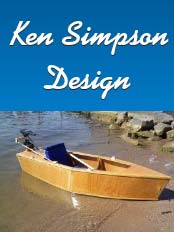
 Custom Search
|
| sails |
| plans |
| epoxy |
| rope/line |
| hardware |
| canoe/kayak |
| sailmaking |
| materials |
| models |
| media |
| tools |
| gear |
| join |
| home |
| indexes |
| classifieds |
| calendar |
| archives |
| about |
| links |
| Join Duckworks Get free newsletter CLICK HERE |
|
|
| Multi-Skiff Building - Part One |
by Clyde Bennish
- Philippines |
|
Banka Boats With all the traveling I do, or used to do, I’ve discovered that Darwin's theories may be stretched to include invention and convention. There seem to be good reasons for what we see in society, including boat designs. Perhaps that explains this notion: When in Rome, do as the Romans. Although, I now have a basic understanding of how and why the Banka boat developed and persists as a functional craft in the Philippines, I have not taken its practicality serious enough to consider the form as my first boat building project. I mean, generally speaking there is nothing wrong with a well-built Philippine Banka boat, it just doesn't conform to the ideal boat my dreams have conjured. A Banka is similar in style to other Polynesian or Pacific island craft that are produced by the thousands each year. Its characteristics are quite recognizable even at a distance, for the single slim top-heavy hull supported by dual bamboo outriggers lends the vessel a certain grace and appeal when seen from a short distance and to the side. They appear to slice through the sea almost without effort. The outriggers may appear ungainly or spidery when viewed up close or from above, but they endow the Banka with many advantages, even in moderate swells. The outriggers provide a level of stability that can only be achieved by catamarans or much larger and heavier vessels with weighted keels or a broad beam. Without the outriggers the Banka would tip over and sink within seconds. I've ridden in some cargo and ferry Bankas with a length of over 40 feet, and the ride is rather comfortable. Smaller 10 foot versions are used as individual fishing vessels; some as short as 10 feet and rigged with lanteen style sails.
They are not difficult to build and require an absolute minimum of tools to construct and maintain. Sail material is usually either split rice bags or poly-tarp; whatever for the owner is available and inexpensive. Their light slim wooden hulls paddle easily and adapt well to inexpensive air-cooled Briggs & Stratton or similarly built low HP engines. When a Banka is constructed and loaded correctly the outriggers produce a minimum of drag. There are few seaworthy boats built with shallower draft or have, for the traditionally constructed solid half-round tree keel, the ability to rest undamaged on a rocky or coral shore-line. The standard fishing Banka of 10 to 14 feet is beached single-handed without much trouble. The outriggers, usually tied to the hull with extreme lengths of high strength mono-filament fishing line, may be removed for refit or long term storage. Bankas are constructed in the darnedest places. I've seen 40 footers hammered together along highway right-a-ways, on the beach, and 10 footers built in narrow alleyways, all with nothing more than a hand saw, hammer, a three dollar hand plane, a thickened cheap version of Asian epoxy, and some copper nails. So, what's wrong with building a Banka as a first boat? Nothing, as long as you plan to limit your lateral movements; the Banka is very narrow, just a foot or two for the average pleasure boat. That doesn’t come close to the beam I always imagined for my first boat. I imagined enough room for friends and camping gear and a mast that reached for the clouds. It would be beamy with a center trunk and sport large white sheets to capture natures energy. I've see it many times during the night when my eyes were closed. Boat Plans I am building a boat called the Multi-Skiff. It's nearly 14 foot length seemed manageable for a first boat, and the free plans looked, at first glance, to contain all the pertinent information - Boy, was I wrong! Describing how I finally interpreted these less than fully developed plans, from which I have so far constructed my ship, gives me a head-ache.
If I knew then what I know now, I would have bypassed the free plans and looked for something a bit easier to decipher. In a manner of speaking you might say that the plans are complete, but deriving data points involved paying close attention to detail and cross referencing all of the drawings. To rely on a single depiction is folly and invites trouble down the road. I would caution anyone considering the use of free internet plans to reconsider the alternative and fork out the bucks for well-developed and supported plans. I strongly encourage all new builders to leave the antiquated, periodical derived and unsupported free plans to the maritime museum curators and their minions. Learn well from a recently initiated free plan zombie (me); just spend the money for good boat plans and be done with it. They are not that expensive when compared to the tangle of mistakes you are likely to make. I really am not a dummy, although you can't convince my wife of it, but my wood working skills have been taxed to the extreme. I had planned to hire some local help to do this or that, but just three days into the project I vowed not to let anyone near my boat with a saw or hammer. I wouldn't trust anyone to follow the boat plans I’m working from; the exception being my retentive father whose skills far exceed my own. He is likely the only other person I know who has enough built in doubt to check the plans five times before cutting wood, and creatively fill in gaps with sound judgment. Just believe this old goat when I suggest that the first time builder would probably be much happier buying a set of current plans from a reputable boat designer. Some pretty good ones can be had for far less than $100. Visiting Neighbor I made most of the boat's individual parts on my balcony. It wasn't until I started assembling them in the driveway that a nearby apartment dweller stopped by for comment. He said that he thought I was a cabinet maker, and that all that tranquility robbing pre-construction woodworking, outside my apartment door, was just furniture making. He thought that those seemingly endless hours of raspy sawing and nettlesome pounding were for something more practical than a mere boat. He said that in the long run I'd probably be happier with an apartment load of newly fashioned furniture, rather than expend quality lumber on the boat; which to him seemed not well adapted for the Philippine Sea. He said that if, by chance, I were to consider building furniture at a reasonable price I might give him a call. In essence, it seemed that no matter how beautiful the partially constructed non-Banka craft sitting before him appeared, he would actually prefer that I use my considerable talents to make him a book case.
I must admit that I was taken back a bit. I have poured a generous number of calories into this project; over half of which were expended in processing the forms and strong-back now supporting the bow, transom, and chine stringers. Nevertheless, I consented to think about his offer, and mentioned that should I ever consider abandoning the trade from which I was semi-retire I would give him a ring. Although I appreciated his having recognized the structure in the driveway as a boat, I have serious doubts as to whether he has ever seen one constructed so diversely from the Banka examples floating around the islands. I am quite sure that he never encountered a locally built boat so well crafted. To be quite frank, the average Banka in these parts lasts but a few years. My unique craft should last more than two score. Next time: Sourcing boat building supplies. |
|





